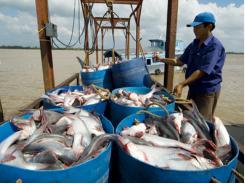South Korea raises scrutiny on frozen Vietnamese shrimp

Other key export markets have taken similar measures, raising simmering concerns about food safety.
South Korea has added frozen shrimp to a list of Vietnamese seafood items subject to inspection for violations of food hygiene and safety standards, according to an official announcement made by the Ministry of Oceans and Fisheries,
The decision, which takes effect on April 1, will add shrimp to a list that includes frozen oysters and abalone.
This isn't the first time South Korea warned Vietnam about food hygiene violations.
In 2013, Seoul subjected Vietnamese shrimp to a year of heightened screening for ethoxyquin, a preservative not approved for use in items meant for human consumption.
South Korea is hardly the first foreign market to ratchet up inspections of Vietnamese seafood.
Officials in Tokyo and Brussels have issued similar edicts.
Today, every consignment of Vietnamese shrimp that enters Japan is screened for the antibiotic sulfadiazine, which is sometimes used by prawn farmers to fight bacteria and promote growth, according to Vietnam’s seafood quality control authority, NAFIQAD. Under normal circumstances, only 30 percent of such imports are subject to inspection, according to the Vietnamese trade commission in Japan.
Local shrimp exporters have been asked to tighten quality controls on their exports to bring sulfadiazine residues below 0.01 parts per million, said Le Hong Phong, deputy head of the NAFIQAD.
According to the Vietnam Association of Seafood Exporters and Producers (VASEP), most of the country's largest export markets have closely scrutinized Vietnamese shrimp for antibiotic residue violations.
Last year, the European Union rejected 11 shipments from Vietnam due to high levels of heavy metals.
The European Commission Rapid Alert System for Food and Feed said the shipments were contaminated with mercury and cadmium.
The number of shipments rejected by the EU in the first nine months of 2016 represented more than twice the number from the whole of the previous year. As a result, inspectors called on exporters in Vietnam to apply extra scrutiny to seafood caught in the four central provinces affected by the Taiwanese Formosa Plastics Group's toxic discharge.
Vietnamese trade commissions in the EU, Japan, and the United States have received about 180 warnings regarding contaminated seafood so far this year.
Even Australia, which has remained the biggest importer of Vietnamese shrimp for five years, imposed a rule that required every seafood shipment from Vietnam to be scrutinized for biological toxins and bacteria.
Last year, Vietnam's seafood exports climbed 7.4 percent from 2015 to nearly $7.05 billion, according to customs statistics. Shrimp exports represented $3.13 billion, or 44 percent, of the total annual exports.
VASEP hopes to export $7.4 billion worth of seafood products this year, a six percent increase from the previous year.
Có thể bạn quan tâm
Phần mềm

Phối trộn thức ăn chăn nuôi

Pha dung dịch thủy canh

Định mức cho tôm ăn

Phối trộn phân bón NPK

Xác định tỷ lệ tôm sống

Chuyển đổi đơn vị phân bón

Xác định công suất sục khí

Chuyển đổi đơn vị tôm

Tính diện tích nhà kính

Tính thể tích ao hồ




 Japanese tariffs hobble Vietnamese tuna exports
Japanese tariffs hobble Vietnamese tuna exports  10% increase in pangasius export value this year
10% increase in pangasius export value this year